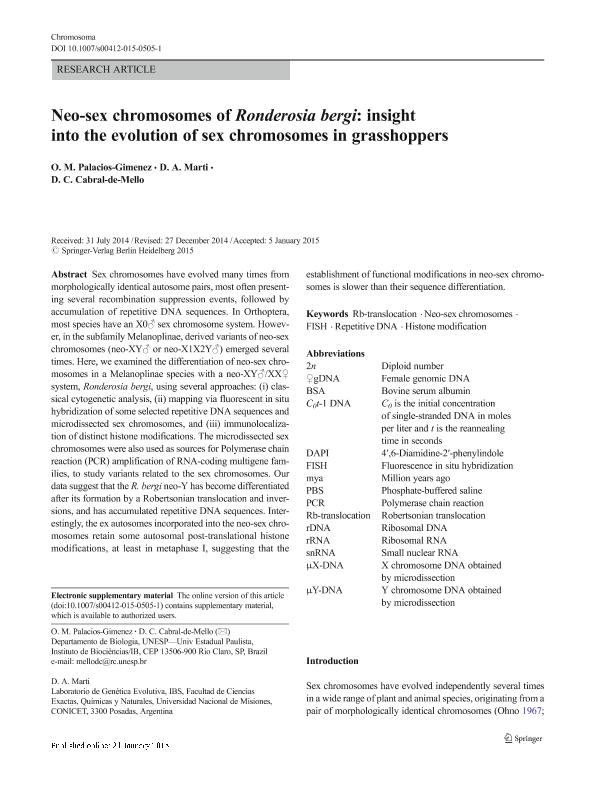Mostrar el registro sencillo del ítem
dc.contributor.author
Palacios Gimenez, O. M.
dc.contributor.author
Marti, Dardo Andrea

dc.contributor.author
Cabral de Mello, D. C.
dc.date.available
2018-02-27T19:45:51Z
dc.date.issued
2015-09
dc.identifier.citation
Palacios Gimenez, O. M.; Marti, Dardo Andrea; Cabral de Mello, D. C.; Neo-sex chromosomes of Ronderosia bergi: insight into the evolution of sex chromosomes in grasshoppers; Springer; Chromosoma; 124; 3; 9-2015; 353-365
dc.identifier.issn
0009-5915
dc.identifier.uri
http://hdl.handle.net/11336/37313
dc.description.abstract
Sex chromosomes have evolved many times from morphologically identical autosome pairs, most often presenting several recombination suppression events, followed by accumulation of repetitive DNA sequences. In Orthoptera, most species have an X0♂ sex chromosome system. However, in the subfamily Melanoplinae, derived variants of neo-sex chromosomes (neo-XY♂ or neo-X1X2Y♂) emerged several times. Here, we examined the differentiation of neo-sex chromosomes in a Melanoplinae species with a neo-XY♂/XX♀ system, Ronderosia bergi, using several approaches: (i) classical cytogenetic analysis, (ii) mapping via fluorescent in situ hybridization of some selected repetitive DNA sequences and microdissected sex chromosomes, and (iii) immunolocalization of distinct histone modifications. The microdissected sex chromosomes were also used as sources for Polymerase chain reaction (PCR) amplification of RNA-coding multigene families, to study variants related to the sex chromosomes. Our data suggest that the R. bergi neo-Y has become differentiated after its formation by a Robertsonian translocation and inversions, and has accumulated repetitive DNA sequences. Interestingly, the ex autosomes incorporated into the neo-sex chromosomes retain some autosomal post-translational histone modifications, at least in metaphase I, suggesting that the establishment of functional modifications in neo-sex chromosomes is slower than their sequence differentiation.
dc.format
application/pdf
dc.language.iso
eng
dc.publisher
Springer

dc.rights
info:eu-repo/semantics/openAccess
dc.rights.uri
https://creativecommons.org/licenses/by-nc-sa/2.5/ar/
dc.subject
Fish
dc.subject
Histone Modification
dc.subject
Neo-Sex Chromosomes
dc.subject
Rb-Translocation
dc.subject
Repetitive Dna
dc.subject.classification
Otras Ciencias Biológicas

dc.subject.classification
Ciencias Biológicas

dc.subject.classification
CIENCIAS NATURALES Y EXACTAS

dc.title
Neo-sex chromosomes of Ronderosia bergi: insight into the evolution of sex chromosomes in grasshoppers
dc.type
info:eu-repo/semantics/article
dc.type
info:ar-repo/semantics/artículo
dc.type
info:eu-repo/semantics/publishedVersion
dc.date.updated
2018-02-27T14:17:35Z
dc.journal.volume
124
dc.journal.number
3
dc.journal.pagination
353-365
dc.journal.pais
Alemania

dc.journal.ciudad
Berlin
dc.description.fil
Fil: Palacios Gimenez, O. M.. Universidade Estadual Paulista Julio de Mesquita Filho; Brasil
dc.description.fil
Fil: Marti, Dardo Andrea. Consejo Nacional de Investigaciones Científicas y Técnicas. Centro Científico Tecnológico Conicet - Nordeste. Instituto de Biología Subtropical. Universidad Nacional de Misiones. Instituto de Biología Subtropical; Argentina
dc.description.fil
Fil: Cabral de Mello, D. C.. Universidade Estadual Paulista Julio de Mesquita Filho; Brasil
dc.journal.title
Chromosoma

dc.relation.alternativeid
info:eu-repo/semantics/altIdentifier/doi/http://dx.doi.org/10.1007/s00412-015-0505-1
dc.relation.alternativeid
info:eu-repo/semantics/altIdentifier/url/https://link.springer.com/article/10.1007%2Fs00412-015-0505-1
Archivos asociados
